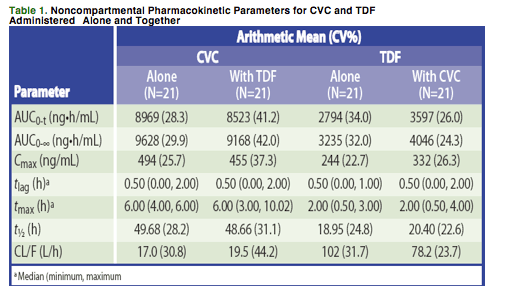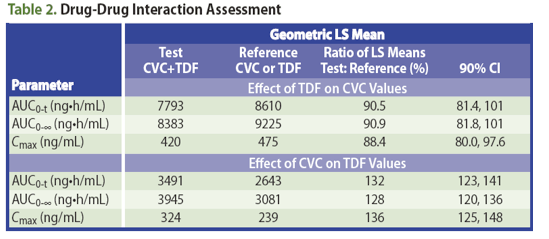 |
 |
 |
| |
Tobira Therapeutics Presents Pharmacokinetics and Safety Data that Support Coadministration of Cenicriviroc with Tenofovir DF in Healthy Adults
|
| |
| |
press release
"CVC (TBR-652) is a CCR5/CCR2 antagonist with potent antiretroviral activity in HIV-1-infected patients.1 The pharmacokinetics, safety, and tolerability of CVC and TDF coadministration were studied in preparation for a phase 2 study using CVC in combination with nucleoside/nucleotide analog reverse transcriptase inhibitors."
Data from Phase I Study Announced at the International AIDS Society (IAS) Conference
Presented at the 6th International AIDS Society Conference on HIV
Pathogenesis, Treatment and Prevention
17-20 July 2011; Rome, Italy
MANALAPAN, N.J.--(BUSINESS WIRE)--Jul 19, 2011 - Tobira Therapeutics, a biopharmaceutical company focused on the development and commercialization of innovative therapies for HIV infection, announced the results of a Phase l, open-label, cross-over study that explored the pharmacokinetics (PK), safety and tolerability of cenicriviroc (CVC) and tenofovir disoproxil fumarate (TDF) when coadministered in healthy adults. The study findings were presented today at the 6th International AIDS Society (IAS) Conference on HIV Pathogenesis, Treatment and Prevention in Rome, Italy.
"These data show that the coadministration of CVC with TDF in healthy adult volunteers did not substantially affect the bioavailability of either drug, thus supporting coadministration as part of HIV treatment regimens in future controlled clinical trials," said David E. Martin, PharmD, Senior Vice President, Drug Development/Regulatory Affairs and lead author of the poster. "We are encouraged by these data as part of our broader CVC clinical development program and are pleased to have recently initiated a Phase llb study in combination with tenofovir disoproxil fumarate and emtricitabine (TDF/FTC), evaluating CVC in treatment-naïve, HIV-infected individuals."
The study presented today at IAS - A Phase I, Open-Label, Single-Dose, Randomized, Cross-Over Study of Cenicriviroc (CVC) and Tenofovir (TDF) in Healthy Volunteers (Poster # TUPE236; Abstract # 710) - assessed the PK, safety and tolerability of CVC administered with and without TDF. Volunteers each received a single dose of CVC, TDF and the coadministration of CVC with TDF with a washout period of 14 days between doses. The potential for a drug-drug interaction was determined by measuring the impact of CVC on TDF's bioavailability and safety profile when coadministered; and conversely measuring the impact of TDF on these same CVC parameters. It was determined that TDF did not significantly impact the rate (Cmax) or extent (AUC 0-t or AUC 0-inf) of plasma exposure of CVC. Conversely, CVC did not impact the extent of absorption of TDF, but it was shown to increase the rate of absorption. There was no effect of CVC on TDF clearance since the TDF half-life was unchanged.
"This study represents a milestone in our clinical development program by demonstrating CVC's ability to be combined with TDF, a key component of most current HIV treatment regimens. As part of Tobira's development strategy, it is essential to demonstrate that CVC can be combined with a range of antiviral agents," said Andrew Hindman, President and Chief Executive Officer. "The full potential of CVC's clinical utility will be determined as its antiviral activity, long-term safety and anti-inflammatory activity (measured via effects on various biomarkers via CVC's effect on CCR2 receptor inhibition) are further investigated in our on-going clinical studies."
About Cenicriviroc
Cenicriviroc (CVC, formerly TBR?652) is a potent antagonist of CCR5, a co?receptor required for HIV infection, and CCR2, a co?receptor involved in the inflammation process that may play a key role in metabolic and cardiovascular diseases. Cenicriviroc is well?differentiated from available and emerging HIV medicines, and shows promise as a highly potent, unboosted, once?daily oral CCR5 antagonist with potentially important CCR2?mediated anti?inflammatory effects.
Clinical data have been presented at key medical meetings including the 2010 International AIDS Conference and the 2010 and 2011 Conference on Retroviruses and Opportunistic Infections (CROI). Key cenicriviroc data have been published in peer?reviewed journals including the Journal of Acquired Immune Deficiency Syndromes (Volume 57, Number 2, June 1, 2011) and Antimicrobial Agents and Chemotherapy (Volume 55, Number 6, June, 2011).
About Tobira Therapeutics Inc.
Tobira Therapeutics is a private biopharmaceutical company focused on developing and commercializing innovative antiviral compounds to treat HIV infection. The Company was founded in 2006 by Eckard Weber, MD, a partner at Domain Associates, LLC, a life sciences venture capital firm. Tobira has assembled a highly experienced management team with decades of clinical and commercial development experience specifically in HIV/AIDS drug development. For more information, please visit www.tobiratherapeutics.com>.
------------------------------
A Phase I, Open-Label, Single-Dose, Randomized, Cross-Over Study of Cenicriviroc (CVC) and Tenofovir (TDF) in Healthy Volunteers
David E. Martin,1 Charles H. Ballow,2 Claudia Jomphe,3 Martin Beliveau,3 JF Marier,3 Reynold Driz,1 Sandra M. Palleja1
1Tobira Therapeutics, Inc., Manalapan, NJ, USA; 2Buffalo Clinical Research Center, Buffalo, NY, USA;
3Pharsight Corporation, Montreal, Quebec, Canada
AUTHOR CONCLUSIONS
· Coadministration of CVC and TDF did not affect the PK of CVC.
· Coadministration of CVC and TDF did not affect the AUC0-t and AUC0-∞ of TDF, the Cmax
of TDF was increased by approximately 36%, suggesting that CVC may affect the rate of
absorption of TDF. Similar conclusions were obtained when assessing the effect of CVC
on the steady-state Cmax of TDF.
· No dose adjustments are necessary when CVC and TDF are co-administered.
· There was no safety contraindication to the administration of CVC in combination with TDF.
ABSTRACT
Background: CVC is a CCR5/CCR2 antagonist with potent antiretroviral activity in HIV-1-infected patients. In preparation for phase 2/3 studies, the pharmacokinetics (PK), safety, and tolerability of CVC and TDF were studied.
Methods: In this open-label, random sequence, cross-over study, 21 healthy volunteers received a single dose each of CVC 150 mg, TDF 300 mg, and CVC 150 mg + TDF 300 mg, with a washout of 14 days between regimens. PK profiles were obtained over a 7-day period after each treatment. Safety was assessed by AE, laboratory, and vital sign assessments; ECGs; and physical examinations.
Results: Coadministration of CVC and TDF did not affect the PK of CVC nor the AUC0-t and
AUC0-∞ of TDF. The Cmax of TDF was increased approximately 36%, with 90% CIs outside the equivalence range, suggesting that CVC may affect the rate of absorption of TDF. The t1/2 of TDF with and without CVC was 20.40 vs. 18.95 hours, respectively. Respective mean CL/F
values of CVC alone and in combination with TDF were 17.0 L/h and 19.5 L/h and of TDF alone and in combination with CVC were 102 L/h and 78.2 L/h. CVC+TDF was well tolerated. There were no deaths, no study discontinuations, and no SAEs; all AEs were of mild intensity.
Fewer AEs were reported with combination therapy than with either drug alone (2, 1, and 0 subjects with drug-related AEs on CVC, TDF, and CVC+TDF, respectively).
Conclusions: Coadministration of CVC and TDF did not affect the PK of CVC nor the AUC0-t and AUC0-∞ of TDF. Coadministration increased the Cmax of TDF, suggesting that CVC may affect the rate of absorption of TDF. There was no safety contraindication to the coadministration
of CVC and TDF.
BACKGROUND
CVC (TBR-652) is a CCR5/CCR2 antagonist with potent antiretroviral activity in HIV-1-infected patients.1 The pharmacokinetics, safety, and tolerability of CVC and TDF coadministration were studied in preparation for a phase 2 study using CVC in combination with nucleoside/
nucleotide analog reverse transcriptase inhibitors.
METHODS
This was an open-label, random sequence, cross-over study to assess the PK, safety, and tolerability of CVC administered with and without TDF. The study population included adult men and women between ages 18 and 55 years old who had had no significant metabolic,
endocrinologic, hepatic, renal, hematologic, pulmonary, cardiovascular, gastrointestinal, urologic, neurologic, or psychiatric disorders; had a body mass index (BMI) between 18 and 30 kg/m2; were willing to take appropriate precautions to prevent pregnancy; had no recent
history (≤30 days) of clinically significant infection; had no positive serology indicative of hepatitis B or C or HIV infection; and had no clinically significant findings on screening evaluations. Subjects received single doses of CVC, TDF, or CVC/TDF in random order, as follows:

Pharmacokinetic Analysis
A PK profile was obtained for CVC and TDF over a 7-day period following each dose, and individual plasma concentrations and PK parameters were summarized by descriptive statistics. The extent of a drug-drug interaction of TDF on the PK of CVC or CVC on the PK of TDF was estimated using a random analysis of variance (ANOVA) model performed on the log-normal (ln) transformed maximum plasma concentration (Cmax), area under the concentration-versus-time curve from predose to the last quantifiable concentration time point (AUC0-t), and AUC from time zero to infinity (AUC0-∞).
Safety Analysis
Safety was assessed based on AE, laboratory, and vital sign assessments; ECGs; and physical
examinations.
Statistical Analysis
A mixed-effect ANOVA model with sequence, treatment, and period as fixed effects and subject nested within sequence as a random effect was applied to the transformed parameters. Calculations of least square (LS) means, differences between adjusted treatment LS means, and the standard error associated with these differences were deduced from this model. Statistical significance was assessed at the two-sided 5% level. The natural In-transformed results were back-transformed to the original scale by exponentiation to obtain geometric LS means for each treatment and geometric LS mean ratios from the concomitant administration of CVC and TDF relative to the single administration of each, with 90% confidence intervals (CIs) around the ratios. Absence of a drug-drug interaction was assumed if the 90% CI around the ratio lay within the equivalence range of 70% to 143%. Steady-state concentrations of TDF with CVC were predicted using nonparametric superposition.
RESULTS
Demographics/Disposition
21 subjects were enrolled: 8 females and 13 males; 17 whites and 4 blacks. Three of the 21 subjects were Hispanic/Latino. Median age was 33 years old (range, 21-53 years). Median BMI was 25 kg/m2 (range, 21-29 kg/m2). All dosing was confirmed by direct observation, and all subjects received all doses.



PK Summary
· The ratios of geometric LS means for AUC0-t, AUC0-∞ and Cmax of CVC were 90.5%, 90.9%, and 88.4%, respectively (Table 2). The absence of drug-drug interaction with TDF, confirmed by the 90% CIs around the ratio of LS mean values completely contained within the equivalence range.
· No drug-drug interactions were observed for AUC parameters of TDF since ratios of LS means and 90% CIs for AUC0-t and AUC0-∞ were within the equivalence range (Table 2).
· The 90% CI for Cmax of TDF fell outside the equivalence range (Table 2), which was attributed to changes in absorption rather than elimination. This hypothesis was supported by the similar t1/2 observed when TDF was administered with and without CVC (20.40 vs. 18.95 h, respectively) (Table 1).
· A moderate accumulation of TDF (AUC0-24) was estimated for multiple once-daily oral administration of TDF alone and in combination with CVC, as indicated by the accumulation factor of approximately 1.5.
· Overall, drug-drug interactions under steady-state conditions should be similar to those observed after single dose administration.
Safety
Table 3. Overall Treatment-Emergent Adverse Events by System-Organ-Class

Safety Summary
· There were no deaths, no discontinuations for AEs, and no SAEs.
· All AEs were reported as mild. Only 4 AEs in 3 patients were considered possibly related to study drug and resolved rapidly; none were considered probably or definitely related to study drug.
· The combination of CVC plus TDF resulted in fewer treatment-emergent AEs than either CVC or TDF alone (Table 3).
· There was a single, isolated grade 3 partial thromboplastin time (PTT) elevation on Day 2 of TDF dosing, which resolved without sequelae. PTT was within normal range at all other times.
· There were no clinically significant or grade 4 laboratory, physical examination, vital signs, or ECG events.
Reference
1. Lalezeri J, Gathe J, Brinson C, et al. Safety, Efficacy, and Pharmacokinetics of TBR 652, a CCR5/CCR2 Antagonist, in HIV 1-Infected,
Treatment-Experienced, CCR5 Antagonist-Naïve Subjects. J Acquir Immuno Defic Syndr 2011 Feb 11 [Epub ahead of print].
|
| |
|
 |
 |
|
|